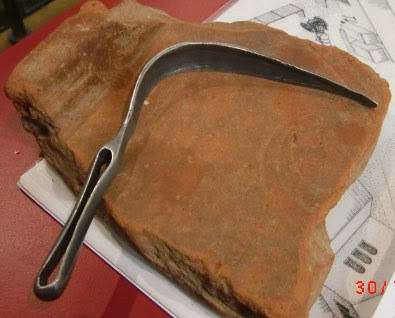 |
| Roman Road and drains (Tunisia) |
As homes did not have running water, very often not even the more luxurious houses belonging to the rich, being able to wash regularly, being able to clean off the dust and grime after having travelled or walked on dusty roads (there was no tarmac!) must have been a real luxury!
Therefore, at least in Imperial Rome, all rich and poor were allowed to enter the Roman Baths and get clean for free. In the case of the Caracalla Baths – the best preserved, visible and perhaps most accessible in Italy – when they first opened access was totally free, later - when given to a ‘management company’ to maintain and regulate their use - an entrance fee was introduced, however it was merely nominal and affordable by even the poorest person.
 |
| View of Caracalla Baths from the gardens (Rome) |
Going back to who and when one could access the baths in ancient Rome - when the bath were first opened - access to the baths was at different times/days for men and women. The baths were opened from noon to sunset and the Caracalla Baths – had approx. 6000-8000 visitors a day and up to 1600 an hour! This gives us an idea of how popular the Baths were.
 |
| Antonine Baths in Carthage (Tunisia) |
Within a short time, women started protesting that they were being discriminated against (sounds familiar?) and eventually they were allowed in the Baths at the same time as the men. Historical notes record of amorous trysts and so on…
What were the Roman Baths for?
They were primarily a place to get clean. However, as the buildings reached the scale of the Caracalla’s or the Diocletian’s Baths, they also provided a place to meet, relax, play and watch games, read – there were libraries in the baths complex – and where plots and conspiracies and lover’s trysts developed. The Roman Baths were the place of major games and sports (i.e. wrestling) and they were the equivalent of say Wembley Stadium in London. People would congregate to watch their favourite athletes compete.
How to take the Baths
Let’s go back to the primary function of the Roman Baths: washing and getting clean. Contrary to what happens nowadays, water was not used to get washed, well not at first. Romans entered the Baths, disrobed and with just a cloth around their waist went in the steam and hot rooms (Calidarium and Laconicum) to sweat it out. There they would get oiled with fragrant unguents by the slaves working in the Baths – or their own personal slaves, if they were wealthy – when ready, the slaves would scrape off the sweat and dirt with the ‘strigil’ which is a fairly scary implement - from my point of view - especially if in the hands of someone you don’t trust 100% (although it is similar to when men go to have a wet shave and allow a total stranger to have a sharp razor to their throat!).
 |
| Strigil |
Anyway, I am digressing… once the bathers had been cleaned up, they would step out of the hot rooms and move to the Frigidarium, the word indicates this was a much cooler room where you would let your body cool down (it was also a place where you would meet fellow bathers) before stepping into the Natatio, or swimming pool of cold water to finish the cooling process. This kind of process reminds me of the Finnish practice of going from the sauna to the freezing waters in northern temperatures…it seems old habits get retained here and there, so there must be some benefits…
In the Caracalla Baths we know there were also rooms, probably on the upper floor, where visitors could have a massage or sunbathe…
Roman historical talks
If this got you intrigued and would like to know more (and are based in Hertfordshire or neighbouring counties) you can book a talk on this or similar subjects (Domus Aurea (Golden House of Nero), Roman Aqueducts…).
I regularly speak to Archaeological & History Societies, WI, etc...
Look forward to hearing from you.

No comments:
Post a Comment